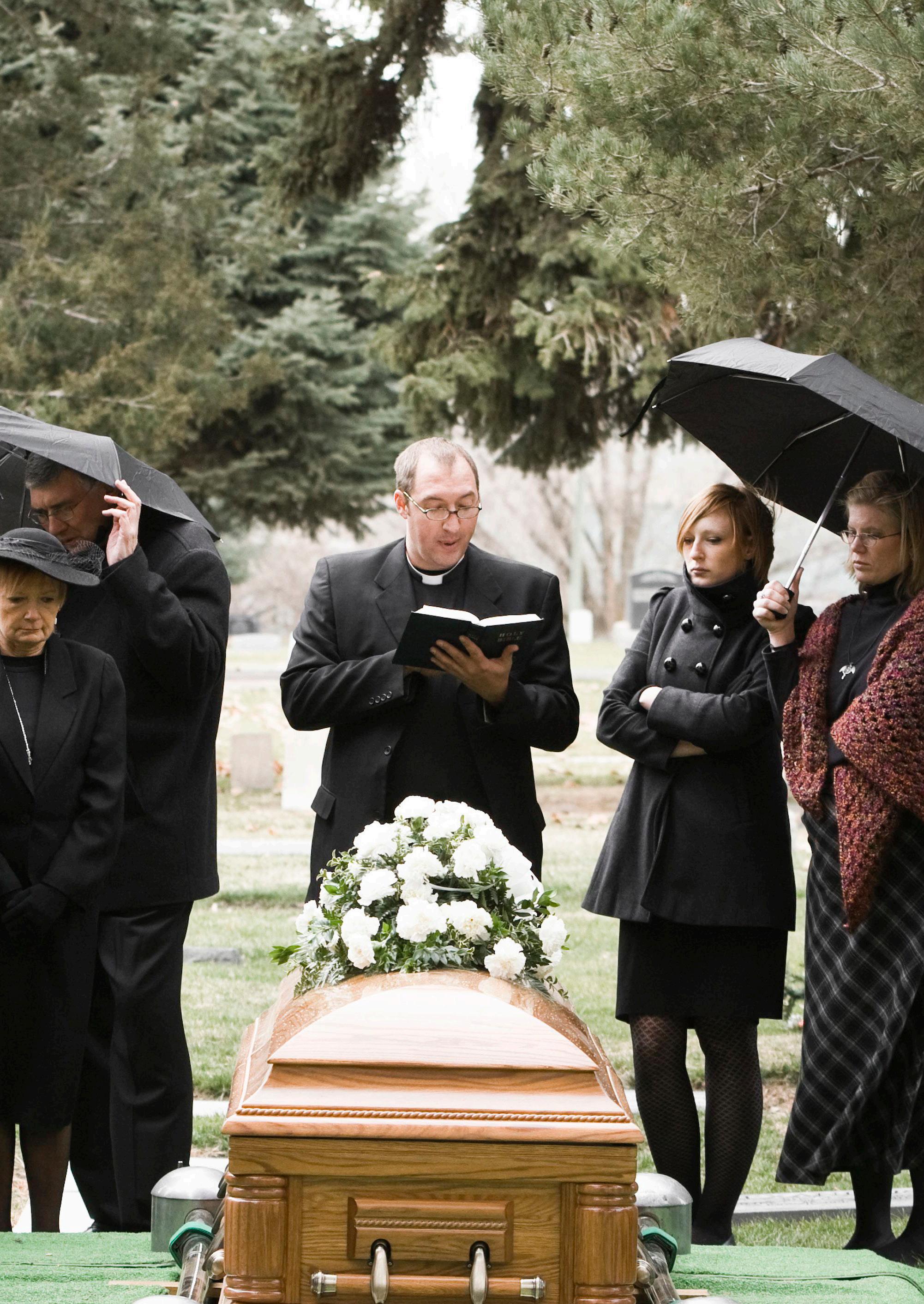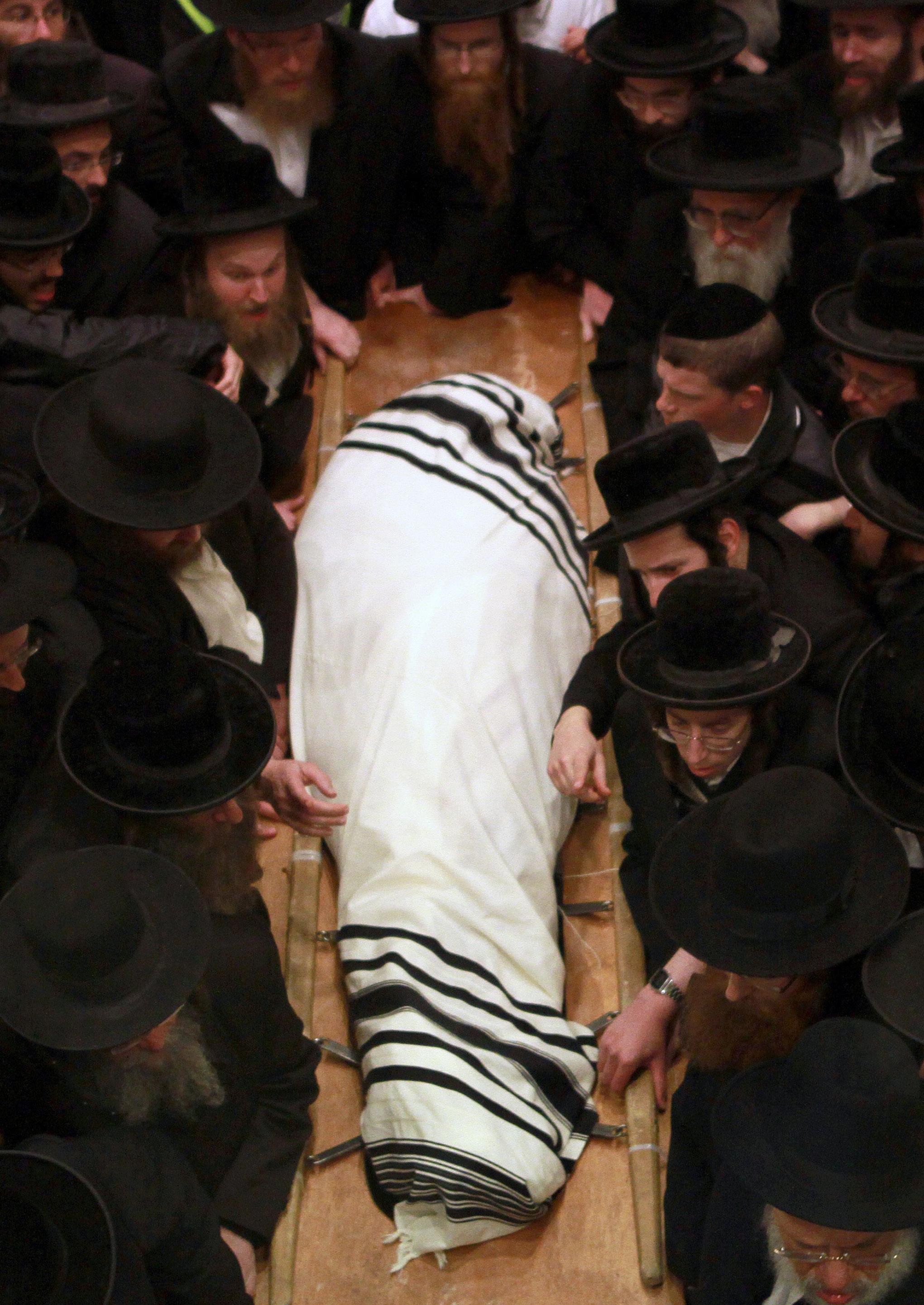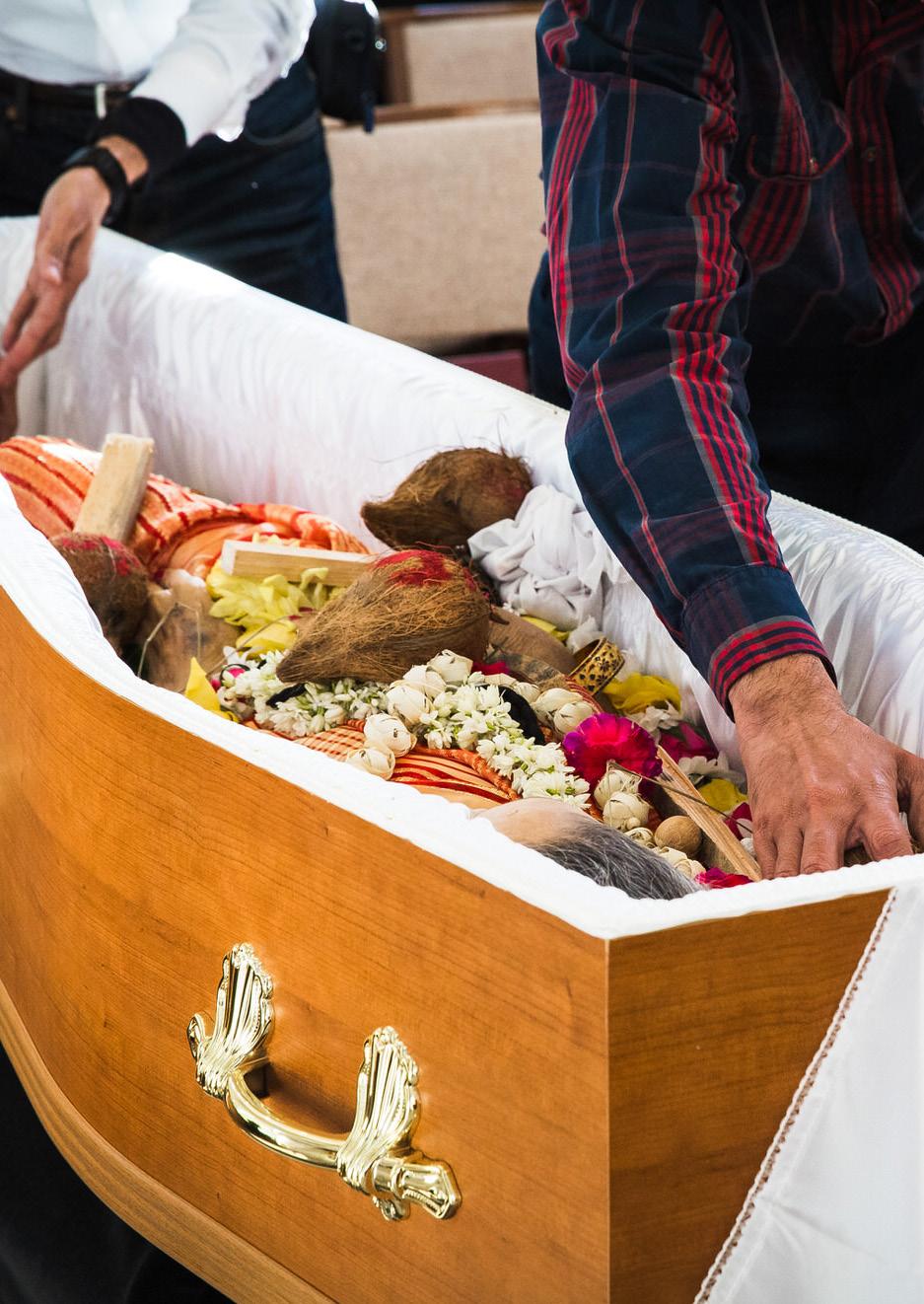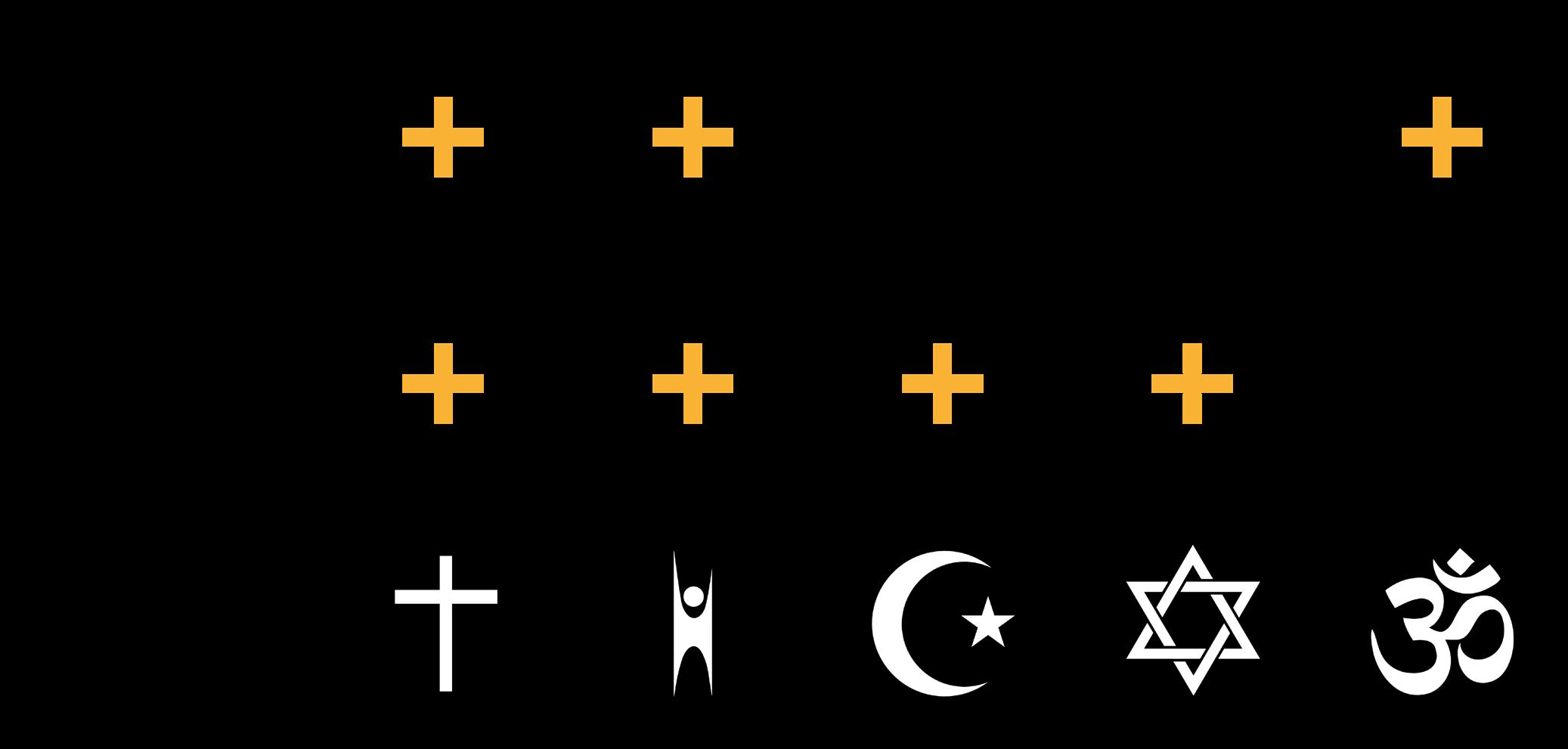
17 minute read
Chapter I Ideal
CHAPTER I IDEAL
When death is viewed from a strictly biological point of view, the logical and sustainable choice would call for the cremation of the deceased. However, humans do not view death strictly from a biological viewpoint. Rather, cultural and religious values result in humans viewing death from a philosophical standpoint by attempting to attach meaning to the passing of a loved one. Therefore, sustainable methods are not always chosen.
Advertisement
Generally humans are prone to a philosophical school of thought. According to the German Philosopher, Arthur Schopenhauer, “the fear of death is the beginning of philosophy, and the final cause of religion.”8 A review of philosophical reasoning concerning death is important to provide a complete interpretation of the human experience of death.
Often the process between the declaration of death and the disposal of physical remains is decided by a human’s personal beliefs, influenced by faith and culture. Hence, the final rites becomes a ritualistic procedure. Once a person is pronounced dead, the family and friends of the deceased are left to mourn and decide the final rites. The final rites are also impacted by cultural, financial and religious backgrounds of the deceased.
This chapter provides an overview of the ideal death, as dictated by the respective religious denomination in London. Both religious and nonreligious groups have sub-groups and organisations called sects where the final rites vary. However, I will be focusing on the core practices that are shared in the larger groups. This chapter aims to provide an understanding of the preferred methods of these larger groups when it comes to the final rites of the deceased. I will reference religious scriptures as evidence for the views that are held, whilst describing the final rites during the funeral ceremonies. The locations and spaces are specific, often essential to fulfil the requirements. The sequential order of the ceremony concludes at the resting of the corpse. Each faith group has preferences of how the deceased are disposed of, by understanding its significance, we can start to understand why it is cherished.
The results of this dissertation will help identify which religious groups, and their funerary practices would need to evolve in order to be sustainable. The main criteria for the requirement of change is whether or not a city, such as London, can sustain their funeral procedures.
CHRISTIANITY
Population in London: 3,937,000 people (44.5%)9 Origin: 30s C.E., Palestine, Middle East Founder(s): Jesus of Nazareth 10
Christianity is a diverse religion with no universal rite of passage within its sects. It branches out into Catholicism, Protestantism, Eastern Orthodox, etc. A similarity between the sects is that they view death as the end of life on Earth and the soul transcends into the afterlife. If one is expected to pass, most individuals of this religion often write a will that includes whether they would prefer burial or cremation, and the selected hymns for the funeral.
Traditionally, funerals are held at a church/chapel by the gravesite, but can also be held at a crematorium or a private funeral hall. A minister, priest or pastor conducts the funeral before the burial. A typical funeral consists of:
The Gathering - The body is presented at the altar of the church in a casket. All those present are seated in the aisle as the priest opens the service. The priest begins with readings from the Bible, Gospel of John, followed by Psalms 23.
Personal readings - The priest will talk about the person who has died. Then a close mourner would read a poem or a passage from the Bible. Following the personal readings, the congregation is given a silent moment of reflection.
Commendation and farewell - The priest reads a final prayer of entrusting and commending before the body is taken for the committal. The committal - This is the most solemn moment of the service. The casket is taken by the mourners to the burial site or furnace. At a burial, this is when the casket is lowered into the grave. At a cremation, the curtains are closed and the casket enters the furnace. 11 Figure 6 exmplies a traditional burial committal.
Christianity is now open to burials and cremations. Traditionally, Christians were buried. The official position of the church changed in the mid 1900s. The facilitator for change in the permit of cremations by Christians is a result of a passage from the First Corinthians:
“So is it with the resurrection of the dead. What is sown is perishable; what is raised is imperishable. It is sown in dishonour; it is raised in glory. It is sown in weakness; it is raised in power. It is sown a natural body; it is raised a spiritual body. If there is a natural body, there is also a spiritual body.” 12
The notion of the spiritual body being resurrected in front of God must be strictly preserved, as the spirit or soul is an immaterial object, cremation is allowed as the spiritual body lives on whilst the physical body turns into ashes.
(Office of National Statistics: ONS, 2019) (Overview of the World’s Major Religions. Cultural Studies: Holidays Around the World, Pearline Jaikumar, 2018) (BBC - Religions - Christianity: Christian funerals, 2009) (BBC - Religions - Christianity: Christian funerals, 2009)

ISLAM
Population in London: 1,255,600 people (14.2%)13 Origin: 7th Century C.E., Arabian Peninsula, Middle East Founder(s): Prophet Mohammed14
Islam is separated into two sects, Sunni and Shia, both share the same rites of passage. Muslims believe in resurrection and life after death. When one dies it is a start of an eternal life in the afterlife called the Akhirah.
When an individual dies the burial follows as soon as possible. Everyone is entitled to the same burial rituals. The body is preferably taken to a Muslim only cemetery, where provisions for the rituals are in place. Alternatively, the body is taken to a mosque before being rested in a multi faith cemetery. These rituals are as follows:
Ghusl (washing) - The body is taken to ‘The Ghusl Room’, where the ceremonious washing takes place. The body is washed in scented water whilst prayers are read quietly, this is done in preparation for burial.
Kafan (Shrouding) - After the Ghusl has been performed, the body is shrouded in sheets of linen cloth called a Kafan. The cloth is made from plain white cotton to display modesty and humility.
Salat al-Janazah (Funeral Prayer) - This takes place either at a prayer hall in the Muslim cemetery or it could take place at open outdoor area near the gravesite. The prayer is similar to the daily prayers Muslims perform. The shrouded body is positioned towards Saudi Arabia, Macca, as the Imam, the leader of the prayer, stands behind the body and the mourners stand in rows behind the Imam. Once the prayers have been said, the body is ready for the burial. Burial - No coffin is used so the body is in direct contact with the earth. The deceased is lowered onto the ground, perpendicular to Mecca. When the body has been placed, everyone present will each throw three handfuls of dirt into the grave. When this is over gravediggers will cover up the burial plot, and everyone present recites one more prayer as the funeral procession leaves. Figure 7 shows a Muslim burial.
Muslim graves are not to be decorated lavishly. The grave marker, usually tombstone, should be simple and may not be raised high.
Cremation and any other means of disposing the dead is completely prohibited. Scholars of the faith refer to the Quran in arguing against cremation, a common passage referred to is from Surah Ta-Ha:
“From this very earth We created you and to the same earth We shall cause you to return, and from it we shall bring you forth to life again.”15 (Surah Ta-Ha 20:55)
The belief that the body is resurrected before God, at the day of judgement, is also core to the Islamic belief system. However, unlike Christianity, the physical condition of an individual when buried is the same condition a Muslim would be resurrected and therefore to be cremated interferes with the spiritual journey after death.

JUDAISM
Population in London: 197,500 people (2.2%)16 Origin: 1800 B.C.E., Palestine, Middle East Founder(s): Prophet Abraham17
In Judaism, the rites of passage for the deceased are universal throughout the faith. There is a strong belief that death has a greater meaning where those who have lived a righteous life are rewarded in the Olam Ha-Ba (The Afterlife).
Preparations for burial should follow quickly as possible. The body is taken to a Jewish cemetery or the central synagogue and the following rituals are required for the rites of passage for Jews:
Tahara (washing) - The body is taken to ‘The Tahara Room’, this where the ritual of washing and purifying the body takes place. The spiritual cleansing is done by pouring warm water all over the deceased, accompanied with recitals of biblical verses.
Tachrichim (Shrouding) - The Tahara is completed by shrouding the body. The shroud, called Tachrichim, is a simple cloth of white linen symbolizing purity and representing equality for all believers. Figure 8 capturis the end of the shrouding process.
Funeral Service - The body is carried to a Jewish cemetery with the funeral procession. The funeral service takes place in the cemetery or in a prayer hall. The service consists of reciting various verses or passages from the Torah directed by the Rabbi. After the scriptures are read the hesped (eulogy) is conducted by the chief mourner. Burial - Judaism does not require coffins and encourages burials without the use of one. The body needs to be in contact with the soil and decompose to become part of the earth. The body is taken to the gravesite by the mourners. Everyone present fills the grave with earth. With the grave filled, the graveside Kaddish (Hymn of Praise to God) is recited by the Rabbi before congregation. With the Kaddish recited, the congregation returns home and the funeral is over.
The tombstone is required for a Jewish grave, the tombstones include the symbol of the Star of David or the Menorah.
Judaism forbids cremation and requires that every individual has a burial. Other methods of funerals are forbidden, Jewish scholars refer to Genesis 3:19 and Deuteronomy 21:23:
“...For dust you are, and to dust you shall return.” 18 (Genesis 3:19)
“You must not let his corpse remain on the stake overnight, but must bury him the same day. For an impaled body is an affront to God: you shall not defile the land that the LORD your God is giving you to possess.”19 (Deuteronomy 21:23) This refers to a command sent down in the case of an executed criminal, to make the argument that all Jewish people, despite being a criminal, are commanded by God to be buried.
(Office of National Statistics: ONS, 2019) (Overview of the World’s Major Religions. Cultural Studies: Holidays Around the World, Pearline Jaikumar, 2018) (The Jewish Publication Society, 1998, p.6) (Jamison and Brereton, 2014, Rigveda: Section 10.16)

HINDUISM
Population in London: 456,800 people (5.2%)20 When Originated: 4000 B.C.E., Indus Valley, Indian subcontinent Founder(s): None21
In Hinduism, beliefs and practices vary widely within its sects. The topic of death has the same teachings across its sects called the Antyesti rites (Last Sacrifice). Hinduism believes in rebirth and reincarnation. Death is the natural process of a soul’s existence as it separates from one body to another.22
When a Hindu dies, the body is taken to the central temple before the procession to the cremation site. The body is taken to a Hindu cremation ground situated on the riverbanks called a Shmashana or a crematorium. The family of the deceased undertakes the following rituals for the rites of passage:
Abhisheka (Holy Bath) - The body is washed by family members at the preparation room. The body is washed with the Holy Ganges water or purified water, this helps the soul break away from its Earthly body. While the body is being washed, mantras are recited throughout the process.23
Shrouding - Once the body is sufficiently cleaned, the body is shrouded in a plain sheet made of linen. The colour of the shroud varies but is commonly white for males and for red for females.
Funeral Procession - The body is placed on a stretcher, and it is decorated with flowers. As the procession proceeds to the cremation ground, participants chant mantras. The chief mourner leads the funeral procession in a stretcher on their shoulders with the deceased’s close relatives. Figure 9 shows the deceased before cremated. Cremation - Hindu cremations are carried out on open air pyres. The stretcher, with the body resting on it, is then laid on the pyre. The presiding family member sprinkles water with kusha grass to purify the cremation area. Following on, the fire is ignited with kusha grass. Throughout this period of time the pandit (priest) recites mantras from the Vedas. When the fire is naturally extinguished, and all the fuel has been consumed the funeral procession returns home.
The ashes of the deceased are collected by the chief mourner a day after cremation. The ashes are scattered into a natural setting with flowing water, this process is called Asthi Visarjan (Immersing the Ashes).
According to the Vedas, the oldest body of religious text in Hinduism, other means of disposing of the dead, that does not include fire or heat, is forbidden. It states in the Vedas, a passage from the hymns of Rigveda:
“When you will make him cooked to readiness, Jātavedas, then impel him forth to the forefathers. When you will have made him cooked to readiness, Jātavedas, then deliver him to the forefathers. When he will embark on the (way) leading to (the other) life, then he will lead at the will of the gods...”24 (Rigveda: Section 10.16) The use of heating the deceased is essential for cremation, it is an extension of the Hindu God of fire called Surya, who cleanses the soul, helping it transport to the next realm of existence.
(Office of National Statistics: ONS, 2019) (Overview of the World’s Major Religions. Cultural Studies: Holidays Around the World, Pearline Jaikumar, 2018) (Jamison and Brereton, 2014, Rigveda: Section 10.16) (Devi, 2018) (Jamison and Brereton, 2014, Rigveda: Section 10.16)

HUMANIST
Population in London: 2,604,600 people (29.4%)25 Origin: 1589 C.E. (Organisation arose in the Nineteenth century C.E.), England, Europe26 Founder(s): None
Since Humanism is a non-theistic group that does not believe in the afterlife with no elements of supernatural or deities. Humanists typically believe that death is annihilation, a state of non-existence, therefore don’t have rites of passage rituals. However, when a Humanist dies a ceremony is done to commemorate the deceased.
When one passes, the family of the deceased contacts a funeral director that will recommend an accredited celebrant by the Humanist UK organisation. The Celebrant is a person who leads the funerary services and helps with the arrangements for the ceremony.
Each ceremony aims to be uniquely orchestrated. There are no rules about what must be included, or in what order. However, many choose to follow the format of traditional funerals. The service is commonly held at a chapel by the grave site, a crematorium or private funeral hall.27 The funeral services follow in this order:
Words of welcome - The body is usually prepared prior and is placed in a casket at the forefront of the ceremony. Mourners are greeted into the funeral and gather to face the casket. The celebrant beginnings the ceremony with thoughts on life and death from a non-religious perspective.
The Tribute - The tribute is read out by the celebrant, it includes special stories of the life and personality of the person who has died. The tribute is based on the information that was given to the Celebrant. Readings of poetry - Following the main tribute, readings of poetry or prose of great meaning are read out. After this, a few moments of reflection are done in silence.
The Committal - The body is taken to the burial plot and lowered into the ground. If the body is cremated, the furnace doors are closed. This is the most emotionally challenging part for mourners and is normally coupled with a few moments of silence. There are some closing words of thanks and the funeral is drawn to a close.28
Figure 10 shows an example of a Humanist funeral ceremony.
Humanists focus on individuality rather than the collectivism observed in religion. A Humanist does not have preferences for any particular method of disposal, with the covenant being that respect is paid to the life of the deceased. Funeral ceremonies are left to the individual to be held wherever they choose.
(Office of National Statistics: ONS, 2019) (Copson and Grayling, 2015, P.1-3) (Ceremony ideas and inspiration, 2019) (Ceremony ideas and inspiration, 2019)
Figure 11: Disposition Preferences within the Faith Groups - By Author

From my research, it is clear that there is room from leniency within some religious groups, Christianity has adopted cremation as an acceptable alternative to traditional burials, and this has now become a norm. The concept of a burial is a significant core belief for many other religions such as Islam and Judaism, these religions reject the idea of cremation with little to no room for change. Figure 11 illustrates these preferences within the faith groups.
This analysis is supported by the extensive research report of Dr Julie Rugg and Nicholas Pleace in 2011, titled “An Audit of London Burial Provision”. It is a report for the Greater London Authority, that estimates the proportion of people opting for cremation from different religious groups, results follow; “27% of people across all Christian denominations collectively opted for burial, while 73% opted for cremation. An estimated 99% of Muslims and 96% of Jews opted for burial. Hindus had a strong preference for cremation, with 90% respectively taking that option. The average across all other faiths was that 68% opted for burial, as did 50% cent of people with no religion.” 29
Providing evidence that 99% of Muslims and 96% of Jewish people choose burial. These two faiths comprise of approximately 1.45 million people in London , a substantially large number of the population opting for burial provisions. This is especially problematic when calculating the average amount of death within these groups; the death rate is approx. 0.5%30 per year, London’s current population of Jews and Muslims would equate to 7250 burial plots per year. The Abrahamic faiths (Christianity, Islam and Judaism) have commonalties in their traditions, where the preference according to the scriptures are all in favour for burials. This agreeable method stems from the belief that the dead would be resurrected on the day of judgement, together with the shared belief on the passage from Genesis 3:19 “...for dust you are, and to dust you shall return.” However, contemporary Christians adopted cremation and it has surpassed burials as the preferable means of disposing the dead, with 73% opting for cremation. If Christianity can evolve their burial methods, shifting in favour for cremation, why can’t Islam and Judaism do the same?
The analysis of funeral traditions was indicative of how susceptible some religious groups are to adaptation over time. Funerary rituals have evolved over time to better suit the climate, laws and other conditions based on surrounding context. For example, In Islam and Judaism, it is prescribed to be buried as quick as possible following a death. In the Middle East, where these religions originated from, the climate is extremely hot and it is understandable to avoid exposed decaying corpses for too long, these were practical solutions at the time and therefore not completely based on religion.
These religions where established thousands of years ago when the planet was largely uninhabited; Judaism is approximately 3,820 years old and Islam is approximately 2,72031 years old. The population of the world did not exceed 210 million people, now it is 7.5 Billion. In ancient times it is understandable for everyone to be buried because the concern for land usages was not an issue. Despite being insusceptible to change throughout centuries, the religious practices of burials have to be replaced with different disposal methods.
(Cemetery Research Group, University of York, 2011) (Omer, 2020) (Overview of the World’s Major Religions. Cultural Studies: Holidays Around the World, Pearline Jaikumar, 2018)
Figure 12: Current capacity status of burials in the London – by Dr Julie Rugg and Nicholas Pleace 2011







